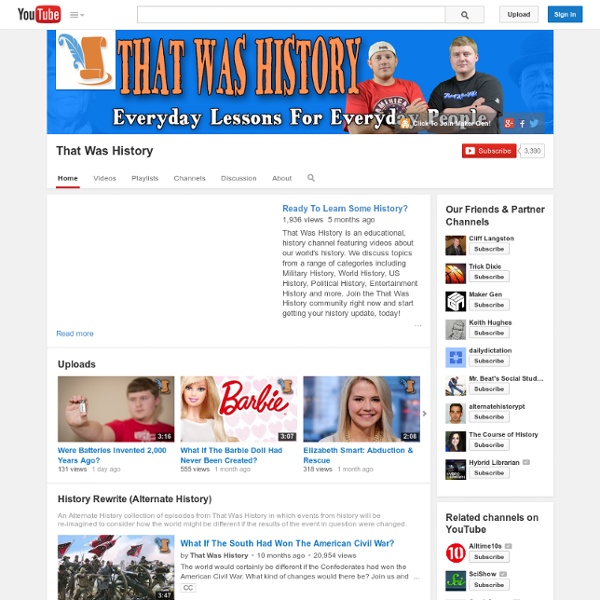



Medieval History Lectures: Dr. Lynn H. Nelson Please take into consideration the purpose and audience for which the lecture notes listed above were written. For a good many years, I taught a three-credit-hour freshman survey entitled Introduction to Medieval History to enrollments of room-size - generally three hundred students. During those years, the University of Kansas maintained an open enrollment policy in which all graduates from accredited Kansas high schools were admitted to the University. Since the only history courses required by the State of Kansas at the secondary level were in American History, students enrolling for this course varied widely in their knowledge of the European past. Consequently, my lectures were both basic and episodic, concentrating on major events and topics that would prepare the students for further enrollments in Humanities courses and attempting to demonstrate that the study of History could be both useful and enjoyable.
U.S. History: Free streaming history videos and activities TheHistoryNet: From the World's Largest History Magazine Publisher America before Columbus History books traditionally depict the pre-Columbus Americas as a pristine wilderness where small native villages lived in harmony with nature. But scientific evidence tells a very different story: When Columbus stepped ashore in 1492, millions of people were already living there. America wasn't exactly a New World, but a very old one whose inhabitants had built a vast infrastructure of cities, orchards, canals and causeways. The English brought honeybees to the Americas for honey, but the bees pollinated orchards along the East Coast. Thanks to the feral honeybees, many of the plants the Europeans brought, like apples and peaches, proliferated. Some 12,000 years ago, North American mammoths, ancient horses, and other large mammals vanished. Settlers in the Americas told of rivers that had more fish than water. In 1491, more people lived in the Americas than in Europe. It’s believed that the domestication of the turkey began in pre-Columbian Mexico, and did not exist in Europe in 1491.
Arte e Historia - Personas WIP Personaswip te ofrece más de 4000 productos terapéuticos y adaptados En nuestra tienda online personaswip.com podrás adquirir más de 4000 productos pensados para mejorar la vida de personas con diferentes diversidades funcionales y síndromes. Además ofrecemos todo lo necesario para facilitar la tarea tanto a familiares de personas en situación de dependencia como a sus cuidadores. Personaswip trabaja con profesionales sociosanitarios y educativos Personaswip.com es la tienda online que ofrece productos terapéuticos y adaptados para profesionales sociosanitarios y educativos como psicólogos, terapeutas ocupacionales, trabajadores sociales, médicos, personal sanitario, neuropsicólogos, fisioterapeutas, cuidadores profesionales, logopedas, animadores socioculturales, profesores, profesores de educación especial, orientadores educativos, etc. Personaswip distribuye a centros sociosanitarios y educativos
9 Totally NOT Boring History Movies for Kids Welcome back to the 2nd part of our Summer Movies for Kids series! Last week, we featured outstanding kids books that were made into movies -- this week, we're focusing on movies that make history FUN! When I was younger, I would complain to my Grandmother about my history homework all the time! I hated memorizing all those dates. I never understood why we had to know what happened in the past. It was all so boring to me. But there was a method to my madness -- you see, my Grandmother LOVED history! When I started complaining, she would tell me super interesting stories about the topic -- things they never taught in the classroom. And I quickly learned that was the key -- find a way to make learning about the past interesting! In addition to sharing some of our favorite history movies, we're also listing hands-on activities that will help kids to dig a little deeper and learn about some of the historic events and people introduced in each film. Now you might be thinking "How is Mr.
American English Dialects North American English Dialects, Based on Pronunciation Patterns Small-Scale Dialect Map The small map below is the same as the Full-Scale Dialect Map that follows, but shows the entire width of the map (on most monitors). 24-Aug.-2010 Click on any part of this map to move to the equivalent part of the Full-Scale Dialect Map. (For now this only moves to the far left or the far right of the Full-Scale Dialect Map, so unfortunately it doesn’t work well for the middle portions, and you will just have to scroll over.) 24-Aug.-2010 Full-Scale Dialect Map Instructions For many of the cities or towns on this map, you can listen to an audio or video sample of speech of a native (more specifically, someone who was raised there, though not necessarily born there, and whose dialect clearly represents that place). Use the scroll bars to move around on this map, or, even simpler, start at the tiny map above and click the country (U.S. or Canada) that you want to look at. Help! Map Notes Other Sources 1.